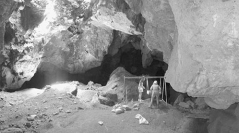

 Comptes Rendus Palevol
9 (8) - Pages 487-497
Comptes Rendus Palevol
9 (8) - Pages 487-497For the first time unequivocal fossil remains of a green toad (Bufo viridis s.l.) are described in the Iberian Peninsula. The fossils come from the Cueva Victoria site, a late Early Pleistocene (ca. 1.1–1.2 Ma) karstic filling in semi-arid southeastern Spain (Murcia region). By extension, other remains from two other Early Pleistocene Spanish localities, Barranco León D (ca. 1.3 Ma) and Almenara-Casablanca 3 (ca. 1.1 Ma), are cautiously attributed to the group B. viridis. The B. viridis group was previously reported with some uncertainty to the west of its current distribution area in Western Europe (Spain and France) in the Pliocene (Bufo cf. viridis) and less probably in the Early Miocene (Bufo aff. viridis). Since no osteological differences have been established between the recently described extant species of B. viridis s.l. (e.g. Bufo balearicus, Bufo siculus, Bufo boulengeri, B. viridis sensu stricto and Bufo variabilis) no precise palaeobiogeographical relationships can be drawn for the Spanish fossils. However, the occurrence of a third species of bufonid toad during the Pleistocene in the South of the Iberian Peninsula raises some interesting ecological questions in relation to the local disappearance of the green toad, which can be hypothetically linked to the intensification of the Pleistocene glacial/interglacial climate dynamic or to probable competition with another toad, Bufo calamita.
Semi-arid Spain, Bufo viridis, Palaeobiogeography, Palaeoecology, Pleistocene